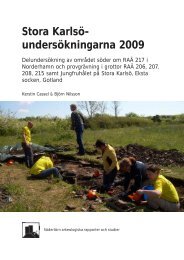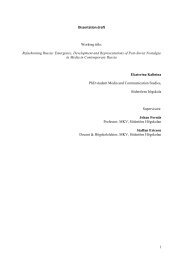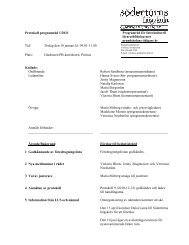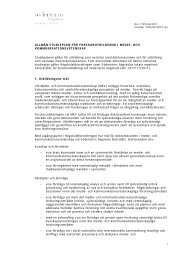CIVIL SOCIETY IN PEACEBUILDING - A Case Study Analysis of ...
CIVIL SOCIETY IN PEACEBUILDING - A Case Study Analysis of ...
CIVIL SOCIETY IN PEACEBUILDING - A Case Study Analysis of ...
You also want an ePaper? Increase the reach of your titles
YUMPU automatically turns print PDFs into web optimized ePapers that Google loves.
conflict. In order for peacemaking and peacekeeping efforts and operations to be truly successful, it hasto include comprehensive efforts to consolidate peace, identify and support structures within the fragilesociety. This process will advance a sense <strong>of</strong> confidence and well being among people. Through talks,negotiations, agreements and most important, integration, ending civil strife can be the only chance forsurvival. Efforts may also include disarming the previously warring parties and the restoration <strong>of</strong> order,the custody and possible destruction <strong>of</strong> weapons, repatriating refugees, advisory and training support forsecurity personnel, monitoring elections, advancing efforts to protect human rights, reforming orstrengthening governmental institutions and promoting formal and informal processes <strong>of</strong> politicalparticipation. An important element in the definition <strong>of</strong> peacebuilding is the work toward reconciliation.It means that peace building should incorporate citizens for the purpose <strong>of</strong> integration that is separatedethnically or by other means.In the case <strong>of</strong> Southern Sudan, peace agreements have focused on top-levelled political andmilitary negotiations. For this reason, peacebuilding is understood within the context <strong>of</strong> top-levelledpolitics, which <strong>of</strong>ten refers to governments, large military units etcetera. Further, the peace buildingprocess should focus on rebuilding institutions and making reforms for the benefit <strong>of</strong> newadministrations, which is a crucial step towards a democratization process and has to be coherent withthe need for reforms in fragile states.Another important factor in peacebuilding is the demobilization <strong>of</strong> armed groups. Demobilizationis <strong>of</strong> great relevance when post-war societies are trying to make efforts to prevent violence. This isimportant because it may reduce the violence and threats for new-armed groups. The prevention <strong>of</strong>group mobilization and criminal activities is essential in the process <strong>of</strong> rebuilding a society.8.1 Analytical frameworkThere is an ongoing debate within peacebuilding theory where scholars are discussing the most effectiveapproach towards peacebuilding within a fragile state. John Paul Lederach, a pr<strong>of</strong>essor <strong>of</strong> InternationalPeacebuilding at the University <strong>of</strong> Notre Dame, Indiana, has constructed a “peacebuilding pyramid”which provides a method to describe different actors role within different levels <strong>of</strong> society. The levelsare: 1) the top elite, 2) the middle-range, and 3) the grassroots (Lederach 1997:38). Each level can becharacterized in terms <strong>of</strong> certain common features. Lederach argues that one must understand the role <strong>of</strong>actors, what actions are best taken at each level in order to determine how effective the approach topeacebuilding is. Since each <strong>of</strong> the three levels play a unique role in peacebuilding, different peaceprocessesmust be adopted at each level <strong>of</strong> the hierarchy. Various activities must be integrated into a19
















